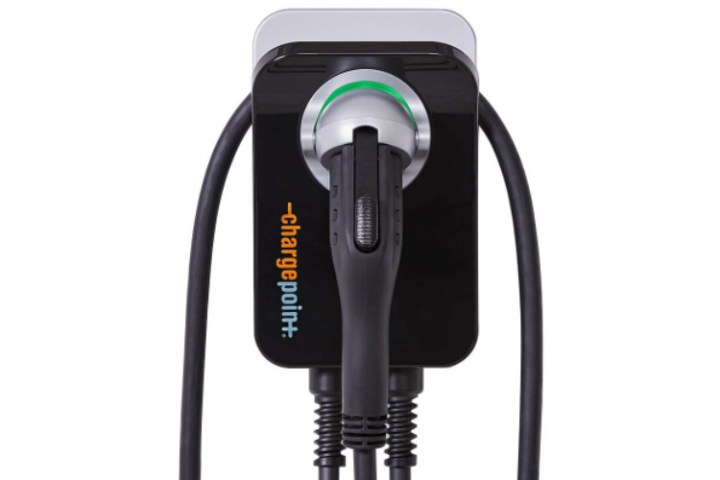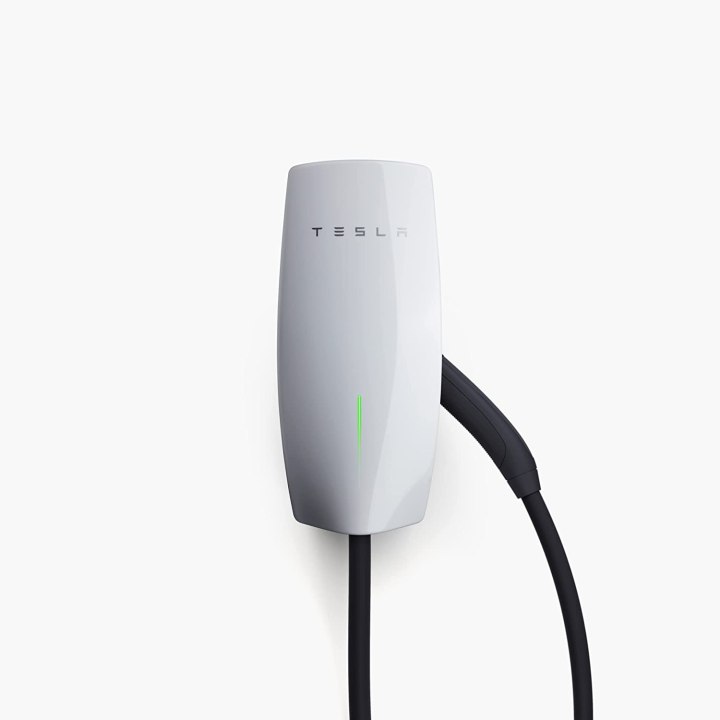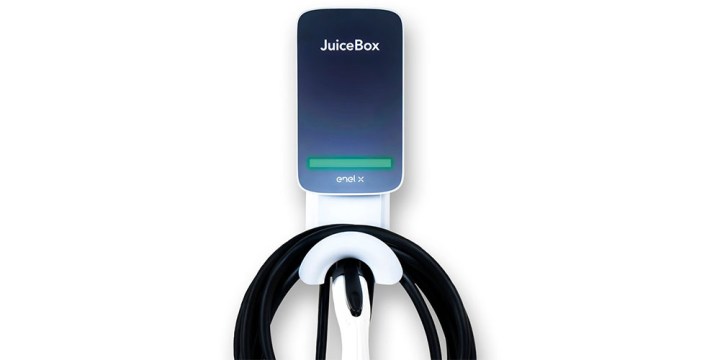
When you brought home your shiny new electric vehicle, it came with a home charging cord. But that was likely a Level 1 charger, which can only add 2 or 3 miles of range per hour. Upgrading to a Level 2 home EV charger can triple that speed — or more — plus provide you with a multitude of options to help lower your electricity bill and extend your car battery life.
In other words, it's now easy to keep your car topped up without ever having to drive to a DC fast charging station unless you're on a road-trip — ensuring that in day-to-day use, your car will stay fully charged, basically all the time.
There are, of course, a few things to note before buying a home EV charger. We're heading toward standardization of charging plugs in the U.S., but that's likely to be a long, drawn-out process. If you own a non-Tesla, chances are your car can charge with a CCS or SAE J1772 connector — but to use that connector on a Tesla, you'll need an adapter to convert that plug to the Tesla NACS connector. Most automakers have announced that they're switching to the NACS connector, so hopefully within a few years all new EVs will have the same port, and charging stations will switch over for added convenience.
The good news is that many home chargers these days are available with the option of a SAE J1772 connector or a NACS connector. Even if you have a car without NACS it might be worth buying a charger with an NACS connector and using an adapter, especially if you plan on replacing your EV in the near future or adding a second EV to your family. Also, it's important to keep in mind that Level 2 chargers can't be plugged into a standard 120-volt outlet, so you'll either need a larger 240-volt outlet or the help of an electrician to actually wire the charger into your home's power. A good middle ground can be having an electrician wire in a new 240-volt outlet, which should be a pretty straightforward process. You also have to make sure your home’s electrical system can handle the charging station in the first place. Manufacturers should provide instructions on how to determine that.
It's wise to check our list of local EV tax credits and incentives before you select a charger, since many local utilities offer generous rebates that may cover most or all of the cost of your charger, but only if you select the right model. Typically utilities incentivize smart, internet-connected chargers that can be remotely throttled back in the event of a brownout. Always check the terms and conditions to make sure you're following them to the letter.
From the best electric vehicle charger manufacturers come our top home EV chargers. Check out the best home EV chargers below.






ChargePoint Home Flex Electric Vehicle Charge
The most versatile option
- Charging speeds up to 50A
- Works with existing ChargePoint app
- Hardwired or plug-in
- NACS or J1772
- Expensive
ChargePoint, also known for its network of public charging stations, offers one model for home charging. The company's latest home model, Home Flex, offers adjustable amperage to 50 amps so owners can match their electrical panel’s or car’s capacity, and it can be scheduled to charge when it's not peak time — for energy and money savings. The charger is available with NACS or J1772 connectors, and the plug-in model can be used outdoors and comes with a NEMA 14-50 or NEMA 5-50 plug. The Home Flex can also be used with the ChargePoint app or Amazon Alexa. Both models are Energy Star certified, making them the only ones on this list. That can be important for rebate eligibility in some scenarios. The ChargePoint app used to control and monitor charging can also be used to locate and pay for public charging stations.
| Hardwired or plug: | Both |
| Plug type: | tktk |
| Amp rating: | Adjustable up to 50 amps |
| Wi-Fi capability: | Yes |
| Cord length: | 23 feet |
| Indoor/outdoor: | Yes |
| Warranty: | 3 years |


Emporia EV Charger
Energy monitoring on a budget
- Reasonably priced
- Fast charging for the price
- NACS or J1772 connector
- App is a little hard to navigate
Emporia has become a well-known energy-monitoring company, and the Emporia EV Charger is a good example of why. The charger is available as a plug-in or hard-wired charger, and has options for a J1772 or NACS connector. It's rated for outdoor use, and can charge your vehicle at up to 11.5kW, which is decently quick. And with its Wi-Fi connectivity, you can monitor charging through the connected app, even though that app isn't the best-designed out there. You can even get a breakdown of electricity pricing.
| Hardwired or plug: | Both |
| Plug type: | J1772 and NACS |
| Amp rating: | Up to 48 amps |
| Wi-Fi capability: | Yes |
| Cord length: | 24 feet |
| Indoor/outdoor: | Yes |
| Warranty: | 3 years |


Tesla Wall Connector
A no-brainer for your Tesla
- Charging speeds up to 48A
- Long four-year warranty
- Sleek design
- No plug-in option
The Tesla Wall Connector is one of the best-designed options on this list, and is set to be a whole lot more useful as more companies adopt NACS — though if you need NACS and J1772, consider the Tesla Universal Wall Connector, which has a built-in adapter. If you have a Tesla, it's a no-brainer to get this over the competition, considering the fact that it can be monitored through the Tesla app so you don't have to manage and download additional apps.
This charger is hardwired, so you'll need to get a professional to install it, and there's no plug-in option. It has a 24-foot cord, and as mentioned, it works with the Tesla app. It's not overly expensive, which is nice, too.
| Hardwired or plug: | Hardwire |
| Plug type: | NACS |
| Amp rating: | Adjustable up to 48 amps |
| Wi-Fi capability: | Yes |
| Cord length: | 24 feet |
| Indoor/outdoor: | Yes |
| Warranty: | 4 years |


Tesla Universal Wall Connector
For multi-EV households
- Sleek and stylish design
- Can switch between NACS and J1772
- Four-year warranty
- A little pricey
Live in a household that uses different plug types for different cars? The Tesla Universal Wall Connector is worth considering. This home charger is more expensive than the NACS-only model, but it comes with an adapter built right into it that can allow it to work with both NACS- and J1772-equipped EVs. It isn't a basic dumb adapter either — the adapter electronically locks onto the end of the cable so you can't lose it.
Like the standard Tesla Wall Connector, the Universal model has a 24-foot cord and a sleek and stylish design that means it should look great in any garage. It has an output capacity of up to 48 amps, and can be controlled straight through the Tesla app.
| Hardwired or plug: | Hardwire |
| Plug type: | NACS and J1772 |
| Amp rating: | Adjustable up to 48 amps |
| Wi-Fi capability: | Yes |
| Cord length: | 24 feet |
| Indoor/outdoor: | Yes |
| Warranty: | 4 years |


JuiceBox 40 Charging Station
Two can play at this game
- Compatible with Google Home and Alexa
- Long 25-foot cord
- Hardwired or plug-in
- One circuit can handle multiple JuiceBoxes
- Expensive
- Maxes out at 40A
- No NACS option (yet)
The Enel JuiceBox comes in 32-amp or 40-amp models and is Wi-Fi-enabled, allowing you to monitor and schedule charging with the JuiceNet mobile app or web portal. The charging station features a built-in cable rack and security lock. You can choose to buy the model that hardwires into your house or the plug-in model that comes with a NEMA 14-50 plug, or the optional NEMA 14-30 or 10-30 plugs.
The charging station can also be controlled and monitored with Amazon Alexa or Google Home. Indoor or outdoor use is possible because the unit is weatherproof, dust-tight, and made of polycarbonate. The JuiceBox makes a smart buy if you think you may someday own multiple EVs, because you can connect multiple JuiceBox charging stations to the same circuit. It isn't available with an NACS connector, but that's apparently coming soon.
| Hardwired or plug: | Both |
| Plug type: | J1772 |
| Amp rating: | 32 and 40 |
| Wi-Fi capability: | Yes |
| Cord length: | 25 feet |
| Indoor/outdoor: | Both |
| Warranty: | 3 years |




